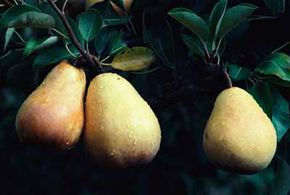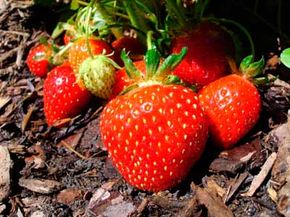So many different kinds of fruit are available, so how do you begin to decide which to grow? Start with quality. When soft berries are homegrown, they can be harvested when fully ripe, plump, and sweet, without concern for shipping and perishability. The flavor is outstanding.
The amount of garden space available will be another deciding factor. Choose between growing small fruits (berries that grow on small plants, vines, or bushes) or larger tree fruits. Start with easily raised, space-efficient small fruits such as strawberries, blackberries, and raspberries. But if you have a place in your landscape for a fruit tree or two, don't pass up the opportunity. Look for easy-care fruit trees or even nontraditional trees such as mulberries or crabapples.
Advertisement
Fruits that Grow on Trees
Traditional orchard trees such as apples, peaches, pears, and cherries require some knowledge and attention to pollination, pruning, pest control, fertilizing, and other kinds of care. To minimize or eliminate spraying for disease, look for new disease-resistant cultivars of apple trees.
- Plant dwarf fruit trees, which stay small enough for you to pick the fruit from the ground. This is a safe, easy way to harvest. You won't have to lug around ladders or balance on them while working. Another advantage of dwarf fruit trees is they begin to bear fruit much younger than full-size trees do. And if your lawn is small, a dwarf tree, which takes up less space than its full-size counterpart, is a good alternative.
- Try growing a super-dwarf peach tree in a pot. Super-dwarfs are extra-miniature trees that may reach only about 5 feet tall. Although other fruit trees come as super-dwarfs, peaches produce flavorful fruit with only one tree and are great for beginners. (Many other fruit trees require a second cultivar for pollination.)
- Plant your super-dwarf peach tree in a 24-inch-wide tub with drainage holes in the bottom. Keep it moist, well fertilized, and in a sunny location during the growing season. If your tree doesn't bear fruit the first year, give it time. It may need another year or two to start its career. During winter in cold climates, store the tree, tub and all, in a cool but protected location.
- Use sticky red balls that resemble apples for control of apple maggots on apple and plum trees. Apple maggots are fly larvae that tunnel into developing fruit, making it disgusting and inedible.
- Apple maggot flies are easily tricked, however. If you put out sticky red balls that resemble apples (homemade or purchased through a garden supply catalog), the egg-laying females will be attracted to the ball and get stuck. (This will end their egg-laying career!) Hang at least one sticky red ball in a dwarf tree and six or more in larger trees.
- Use tree bands to catch crawling pests climbing up fruit tree trunks. Sticky plastic bands will catch ants carrying aphids and creeping caterpillars such as gypsy moths and codling moths.
Find out more simple and easy tips on growing varieties of berries in the next section.
Advertisement

